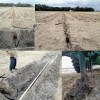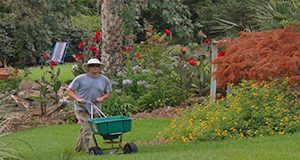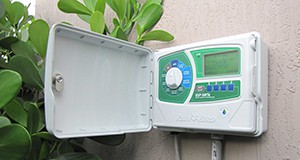Excess nitrogen (N) and phosphorus (P) in water bodies are a leading cause of water quality degradation statewide. More than 50 Florida counties and municipalities now have formal fertilizer ordinances, which in some cases include fertilizer blackouts, or bans on the usage of N and P fertilizers during certain times of the year. This 8-page document provides information on the underlying issues of fertilizer use, with an emphasis on an urban setting, and outlines the current state of the science on urban fertilizers and water quality in Florida. Written by Michael D. Dukes, Lisa Krimsky, Mary Lusk, Laurie Trenholm, Bryan Unruh, Michelle Atkinson, and Rao Mylavarapu, and published by the UF/IFAS Department of Agricultural and Biological Engineering, February 2020.
https://edis.ifas.ufl.edu/ae534
Tag: Michael D. Dukes
Frequently Asked Questions about Evapotranspiration (ET) Irrigation Controllers
Evapotranspiration is the amount of water that is released into the atmosphere through evaporation and plant transpiration. An evapotranspiration irrigation controller is a device that uses data about the landscape, the type of irrigation system, and local weather conditions to determine when and how much to irrigate. This 5-page fact sheet written by Paul Monaghan, Ondine Wells, Michael Dukes, Maria Morera, and Laura Warner and published by the Department of Agricultural Education and Communications explains how the technology functions as well as how to install, program, operate, and maintain an ET controller for a money- and water-wise sustainable home landscape that’s lush and beautiful.
http://edis.ifas.ufl.edu/wc237
Estimated Water Savings Potential of Florida-Friendly Landscaping™ Activities

To help homeowners predict the impact of implementing some of the water conservation measures listed on Florida-Friendly Landscaping™ checklist, this 5-page fact sheet offers a table of estimated water savings. Homeowners can select activities which are the best fit for their landscape and can also see which have the most conservation potential. The water savings is compared to a baseline case of typical irrigation behavior. This 5-page fact sheet was written by Mackenzie Boyer and Michael Dukes, and published by the UF Department of Agricultural and Biological Engineering, August 2015. (Photo credit: Michael Gutierrez, UF/IFAS)
http://edis.ifas.ufl.edu/ae515
Minimum Number of Soil Moisture Sensors for Monitoring and Irrigation Purposes
 Managing soil moisture properly through irrigation is key to increasing crop yield and conserving water. By understanding soil moisture variability, growers can better manage their irrigation systems to apply the right amount of water at the right time. This 4-page fact sheet proposes guidelines for soil moisture sampling that account for spatial variability, which helps to determine the minimum number of soil moisture sensors required to survey and monitor a specific area for irrigation. Written by Lincoln Zotarelli, Michael D. Dukes, and Marcelo Paranhos, and published by the UF Department of Horticultural Sciences, July 2013.
Managing soil moisture properly through irrigation is key to increasing crop yield and conserving water. By understanding soil moisture variability, growers can better manage their irrigation systems to apply the right amount of water at the right time. This 4-page fact sheet proposes guidelines for soil moisture sampling that account for spatial variability, which helps to determine the minimum number of soil moisture sensors required to survey and monitor a specific area for irrigation. Written by Lincoln Zotarelli, Michael D. Dukes, and Marcelo Paranhos, and published by the UF Department of Horticultural Sciences, July 2013.
http://edis.ifas.ufl.edu/hs1222
Subsurface Drip Irrigation (SDI) for Enhanced Water Distribution: SDI – Seepage Hybrid System (HS1217)
 In terms of water use efficiency, the traditional seepage irrigation systems commonly used in areas with high water tables are one of the most inefficient methods of irrigation, though some irrigation management practices can contribute to better soil moisture uniformity. Subsurface drip irrigation systems apply water below the soil surface by microirrigation, improving the water distribution and time required to raise the water table for seepage irrigation. This 6-page fact sheet was written by Lincoln Zotarelli, Libby Rens, Charles Barrett, Daniel J. Cantliffe, Michael D. Dukes, Mark Clark, and Steven Lands, and published by the UF Department of Horticultural Sciences, March 2013.
In terms of water use efficiency, the traditional seepage irrigation systems commonly used in areas with high water tables are one of the most inefficient methods of irrigation, though some irrigation management practices can contribute to better soil moisture uniformity. Subsurface drip irrigation systems apply water below the soil surface by microirrigation, improving the water distribution and time required to raise the water table for seepage irrigation. This 6-page fact sheet was written by Lincoln Zotarelli, Libby Rens, Charles Barrett, Daniel J. Cantliffe, Michael D. Dukes, Mark Clark, and Steven Lands, and published by the UF Department of Horticultural Sciences, March 2013.
http://edis.ifas.ufl.edu/hs1217
Interpretacion del contenido de la humedad del suelo para determinar capacidad de campo y evitar riego excesivo en suelos arenosos utilizando sensores de humedad (AE496)
 Este documento resume las directrices para la determinación de la capacidad de campo y la programación óptima del riego para suelos arenosos utilizando sensores de medición de la humedad del suelo (SHS). Los sensores de humedad del suelo han demostrado potencial para el monitoreo de la humedad del suelo, y para el respaldo en la toma de decisiones de riego en cultivos hortícolas. This 4-page fact sheet was written by Lincoln Zotarelli, Michael D. Dukes, y Kelly T. Morgan, and published by the UF Department of Agricultural and Biological Engineering, January 2013.
Este documento resume las directrices para la determinación de la capacidad de campo y la programación óptima del riego para suelos arenosos utilizando sensores de medición de la humedad del suelo (SHS). Los sensores de humedad del suelo han demostrado potencial para el monitoreo de la humedad del suelo, y para el respaldo en la toma de decisiones de riego en cultivos hortícolas. This 4-page fact sheet was written by Lincoln Zotarelli, Michael D. Dukes, y Kelly T. Morgan, and published by the UF Department of Agricultural and Biological Engineering, January 2013.
http://edis.ifas.ufl.edu/ae496
Interactive Urban Irrigation Tool for Florida (AE485)
A team from UF/IFAS has developed an app for optimizing your home irrigation system using real-time weather data from the Florida Automated Weather Network (FAWN). Learn more in this 5-page fact sheet written by K.W. Migliaccio, N.A. Dobbs, W.R. Lusher, J. Fan, M.D. Dukes, K.T. Morgan, and B. Ferraro, and published by the UF Department of Agricultural and Biological Engineering, March 2012.
http://edis.ifas.ufl.edu/ae485
Net Irrigation Requirements for Florida Turfgrass Lawns, Part 1: Report of Gathered Weather Data and Quality Check (AE480)
 Urban water users need specific recommendations to irrigate efficiently and for planning and regulatory programs.The first step in the process of estimating net irrigation requirements is to check the quality of 30 years of weather data at ten different locations in Florida and one in Alabama. This 9-page fact sheet was written by Consuelo C. Romero and Michael D. Dukes, and published by the UF Department of Agricultural and Biological Engineering, August 2011. (AP photo by Milt Putnam, University of Florida/IFAS)
Urban water users need specific recommendations to irrigate efficiently and for planning and regulatory programs.The first step in the process of estimating net irrigation requirements is to check the quality of 30 years of weather data at ten different locations in Florida and one in Alabama. This 9-page fact sheet was written by Consuelo C. Romero and Michael D. Dukes, and published by the UF Department of Agricultural and Biological Engineering, August 2011. (AP photo by Milt Putnam, University of Florida/IFAS)
http://edis.ifas.ufl.edu/ae480
Net Irrigation Requirements for Florida Turfgrass Lawns, Part 2: Reference Evapotranspiration Calculation (AE481)
 Urban water users need specific recommendations to irrigate efficiently and for planning and regulatory programs. As the second step in the process of estimating net irrigation requirements, This 9-page fact sheet calculates reference ET for ten locations in Florida and one in Alabama. Written by Consuelo C. Romero and Michael D. Dukes, and published by the UF Department of Agricultural and Biological Engineering, August 2011. (Image from ca.gov)
Urban water users need specific recommendations to irrigate efficiently and for planning and regulatory programs. As the second step in the process of estimating net irrigation requirements, This 9-page fact sheet calculates reference ET for ten locations in Florida and one in Alabama. Written by Consuelo C. Romero and Michael D. Dukes, and published by the UF Department of Agricultural and Biological Engineering, August 2011. (Image from ca.gov)
http://edis.ifas.ufl.edu/ae481
Net Irrigation Requirements for Florida Turfgrass Lawns, Part 3: Theoretical Irrigation Requirements (AE482)
 Urban water users need specific recommendations to irrigate efficiently and for planning and regulatory programs. This 21-page fact sheet estimates net irrigation, effective rainfall, and drainage by using a water balance equation for ten locations in Florida and one in Alabama from data during the 30-year period of 1980-2009. Written by Consuelo C. Romero and Michael D. Dukes, and published by the UF Department of Agricultural and Biological Engineering, August 2011. (UF/IFAS Photo: Josh Wickham)
Urban water users need specific recommendations to irrigate efficiently and for planning and regulatory programs. This 21-page fact sheet estimates net irrigation, effective rainfall, and drainage by using a water balance equation for ten locations in Florida and one in Alabama from data during the 30-year period of 1980-2009. Written by Consuelo C. Romero and Michael D. Dukes, and published by the UF Department of Agricultural and Biological Engineering, August 2011. (UF/IFAS Photo: Josh Wickham)
http://edis.ifas.ufl.edu/ae482
A Guide to EPA’s Numeric Nutrient Water Quality Criteria for Florida (SL316/SS528)
This revised 10-page guide provides a basic, concise, and understandable description of the United States Environmental Protection Agency’s (EPA) numeric nutrient criteria for Florida, the background events that led to its release, some pertinent scientific issues, and implications for the future. Written by Thomas Obreza, Mark Clark, Brian Boman, Tatiana Borisova, Matt Cohen, Michael Dukes, Tom Frazer, Ed Hanlon, Karl Havens, Chris Martinez, Kati Migliaccio, Sanjay Shukla, and Alan Wright, and published by the UF Department of Soil and Water Science, March 2011.
http://edis.ifas.ufl.edu/ss528
Frequency of Residential Irrigation Maintenance Problems (AE472/AE472)
The majority of Florida in-ground irrigation systems have some type of maintenance problem that could be causing excessive water use. Inspections should be done on a regular basis. This factsheet describes the five residential irrigation problems that represented half of the problems found in 3,416 audits by Urban Mobile Irrigation Labs in Florida. This 7-page fact sheet was written by Thomas R. Olmsted and Michael D. Dukes, and published by the UF Department of Agricultural and Biological Engineering, January 2011.
http://edis.ifas.ufl.edu/ae472
AE460 Interpretation of Soil Moisture Content to Determine Soil Field Capacity and Avoid Over-Irrigating Sandy Soils Using Soil Moisture Sensors
AE460, a 4-page illustrated fact sheet by Lincoln Zotarelli, Michael D. Dukes and Kelly T. Morgan, demonstrates how to correctly interpret capacitance-based soil moisture measurement devices to accurately measure volumetric soil moisture in sandy soils common to Florida. Includes references. Published by the UF Department of Agricultural and Biological Engineering, February 2010.
http://edis.ifas.ufl.edu/ae460
AE456 Evapotranspiration-Based Irrigation for Agriculture: Crop Coefficients of Some Commercial Crops in Florida
AE456, a 4-page fact sheet by Isaya Kisekka, Kati W. Migliaccio, Michael D. Dukes, Jonathan H. Crane, and Bruce Schaffer, identifies typical Kc values for some of the crops commonly grown in Florida. Includes references. Published by the UF Department of Agricultural and Biological Engineering, January 2010.
http://edis.ifas.ufl.edu/AE456
AE458 Evapotranspiration-Based Irrigation for Agriculture: Implementing Evapotranspiration-Based Irrigation Scheduling for Agriculture
AE458, a 4-page fact sheet by Isaya Kisekka, Kati W. Migliaccio, Michael D. Dukes, Jonathan H. Crane, and Bruce Schaffer, outlines step-by-step procedures to follow when implementing a "smart" evapotranspiration (ET)-based irrigation schedule and a do-it-yourself irrigation schedule. Includes references. Published by the UF Department of Agricultural and Biological Engineering, January 2010.
http://edis.ifas.ufl.edu/AE458
AE457 Evapotranspiration-Based Irrigation Scheduling for Agriculture
AE457, a 6-page fact sheet by Isaya Kisekka, Kati W. Migliaccio, Michael D. Dukes, Jonathan H. Crane, and Bruce Schaffer, focuses on the main concepts related to ET-based irrigation scheduling and reviews the use of "smart" irrigation scheduling controllers for agricultural applications. Includes references. Published by the UF Department of Agricultural and Biological Engineering, January 2010.
http://edis.ifas.ufl.edu/AE457
AE455 Evapotranspiration-Based Irrigation for Agriculture: Sources of Evapotranspiration Data for Irrigation Scheduling in Florida
AE455, a 4-page fact sheet by Isaya Kisekka, Kati W. Migliaccio, Michael D. Dukes, Bruce Schaffer, Jonathan H. Crane, and Kelly Morgan, lists some of the public sources of ETo data for irrigation scheduling in Florida. Includes references. Published by the UF Department of Agricultural and Biological Engineering, January 2010.
http://edis.ifas.ufl.edu/AE455
AE459 Step by Step Calculation of the Penman-Monteith Evapotranspiration (FAO-56 Method)
AE459, a 12-page fact sheet by Lincoln Zotarelli, Michael D. Dukes, Consuelo C. Romero, Kati W. Migliaccio, and Kelly T. Morgan, provides a step-by-step calculation of the reference evapotranspiration (FAO-56 method) for a given location from the available weather data. Includes references. Published by the UF Department of Agricultural and Biological Engineering, February 2010.
http://edis.ifas.ufl.edu/ae459
SL316/SS528 A Guide to EPA’s Proposed Numeric Nutrient Water Quality Criteria for Florida
SL316, a 9-page illustrated guide by Thomas Obreza, Mark Clark, Brian Boman, Tatiana Borisova, Matt Cohen, Michael Dukes, Tom Frazer, Ed Hanlon, Karl Havens, Chris Martinez, Kati Migliaccio, Sanjay Shukla, and Alan Wright, provides a basic, concise, and understandable description of the United States Environmental Protection Agency’s (EPA) proposed numeric nutrient criteria for Florida, the background events that led to its release, some pertinent scientific issues, and implications for the future. Published by the UF Department of Soil and Water Science, February 2010.
http://edis.ifas.ufl.edu/ss528
AE451 Basic Repairs and Maintenance for Home Landscape Irrigation Systems
AE451, a 7-page illustrated fact sheet by Mary S. McCready, Michael D. Dukes, and Kati Migliaccio, instructs homeowners in how to detect and repair some basic problems of automatic irrigation systems — clogged sprinklers, sprinkler and valve leaks, obstructed prinklers, overspray, missing nozzles, and design problems. Published by the UF Department of Agricultural and Biological Engineering, September 2009.
http://edis.ifas.ufl.edu/AE451

